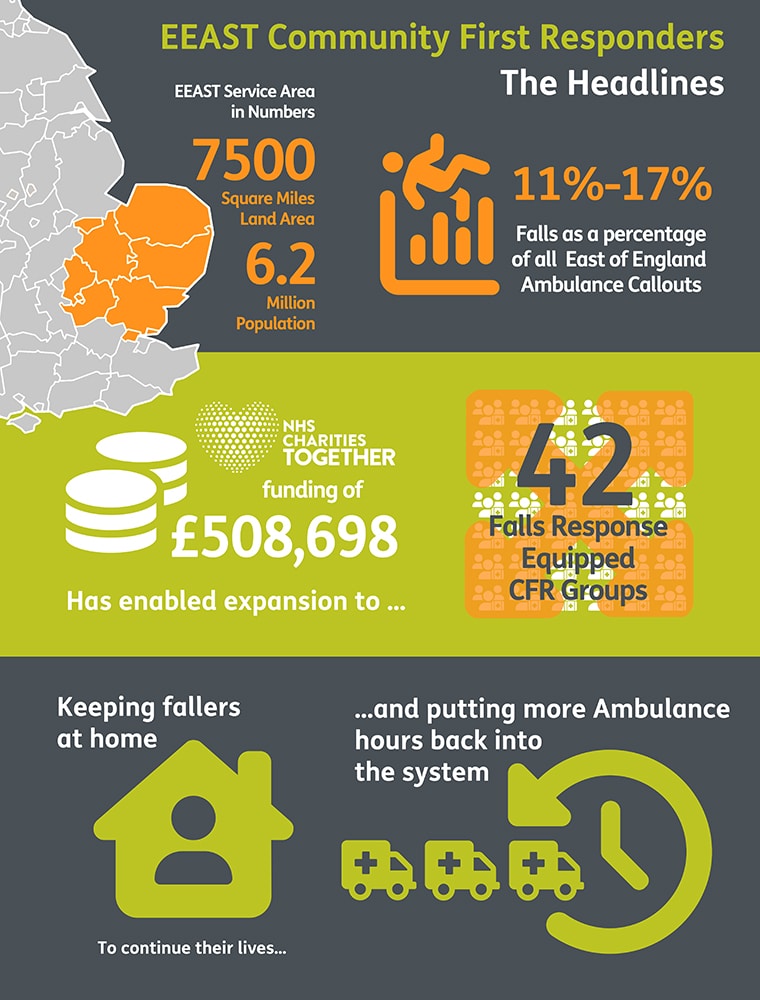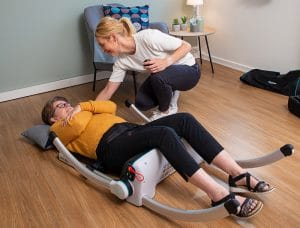How East of England Ambulance Service CFRs are using Raizer Chairs to put more ambulance hours back into the system
Case Study at a Glance
East of England Ambulance Service (EEAST) have upskilled CFR groups in falls response and have equipped them with Raizer Lifting Chairs to enable a quick response to non-injury falls. This is improving patient experiences and outcomes by preventing long lies following a fall and enabling persons to remain in their own homes – whilst empowering the CFRs and putting more ambulance hours back into the system
The Headlines

The Case Study Video
The Challenge: Uninjured Fallers Putting Pressure on the Ambulance Service
The East of England Ambulance Service Trust (EEAST) covers the counties of Norfolk, Bedfordshire, Cambridgeshire, Essex, Hertfordshire and Suffolk – an area of around 7,500 square miles, and a population of approximately 6.2 million.
As an Ambulance service, East of England have had Community First Responders (CFRs) since 1997. When this programme started it was focussed on the out of hospital cardiac arrests and having defibrillators operated by volunteers in local rural communities. As the CFR programme has progressed, EEAST have identified that there is another group of patients that require medical attention: persons that have fallen in the community, who haven’t injured themselves, but are unable to get themselves up from the floor. Falls are a high volume component of 111 and 999 calls, making up between 11% and 17% of EEAST’s Ambulance callouts, depending on the time of year.
There are effectively three groups of fallers;
- Injured fallers: A hip fracture or other condition that necessitates an ambulance response
- Non-injured fallers: not injured, but simply cannot get themselves off the floor
- Minor injury fallers: minor bleeding or pain in addition to requiring lifting from the floor, but with treatment on scene can remain at home.
The only support fallers had previously was to call 999. However, EEAST will always prioritise critical care patients and cardiac arrest patients (Category 1 and 2 callouts) over getting a fallen person up off the floor (Category 3 or 4). And a patient that has been on the floor for longer than an hour will suffer from a long lie and is potentially going to need hospital treatment when the ambulance does then get to them – increasing demand and pressure on the NHS.
It was clear that there needed to be a new and better way to respond to non-injury falls – by utilising volunteer CFRs.
The Solution: Equipping CFRs with Raizer Emergency Lifting Chairs
NHS Charities Together have awarded £508,689 to EEAST to enhance the role of CFRs. Using this funding, EEAST have been able to identify 18 communities with a particularly high volume of 999 calls relating to falls, and that have existing CFR groups that can be upskilled. EEAST have trialled a model across those 18 CFR groups where they pick up non-injury fallers in the community, with the necessary training to carry out a patient assessment and lift a patient up off the floor with a lifting aid, quickly and safely.
The CFRs are linked via radio with the clinical advice line in the EEAST control room. By having a professional clinician ready and available to remotely assist with discharging the patient on scene, EEAST can be ensure that the patient hasn’t got any underlying problems that may need an onsite clinical assessment by a paramedic or ambulance (rather than resting this responsibility solely on a volunteer). Additionally, the falls trained CFRs will be able to link patients to local support services and care pathways – providing access to the right resources to limit future falls or possible injury.
CFRs normally operate individually from their own homes. In the past, when responding to cardiac arrests and breathing problems, they would be backed up by a double-crewed Ambulance. However, in transitioning to a single person response to falls in the community, it was essential that the CFRs were equipped with lifting devices that enabled single-handed lifting of fallen persons.
To this end, Felgains have equipped the EEAST CFR teams with Raizer Emergency Lifting Chairs – enabling them to respond single-handedly and get fallen persons up off the floor quickly, smoothly and safely.
What is the Raizer?The Raizer is a motorised lifting chair that assembles around a fallen person and lifts them up to a seated or perching position. It is easy to assemble and use for the caregiver, and it is safe, smooth and very reassuring for the fallen person.
|
 |
The Impact and Results: High Leave at Home Rates, Empowering CFRs and Putting Ambulance Hours back into the System
By getting to the fallen patients quickly, making sure they’re not injured, and lifting them up off the floor, EEAST can provide a much better patient experience, and the fallen person can remain in their own home – which is better for them and means they can continue their normal life.
What EEAST have seen from the pilot is a very high leave at home rate with no ambulance backup required, and some very positive patient experiences where the fallen person has received a rapid response – often within 15-20 minutes – and been able to remain in their own home. The pilot has also provided very positive experiences for the volunteer CFRs themselves, who feel empowered to give more back to their communities – a factor that is especially important to them.
EEAST have seen the positive impact of less ambulance callouts. As this programme progresses, the CFRs will be dealing with hundreds more patients in the course of a year. This not only makes a big difference in improving patient experiences and outcomes, it effectively gives EEAST more ambulance hours back into the system to respond faster to category 1 and 2 calls.
“Looking at where we are going with these [falls response CFR] groups, it’s going to be looking at dealing with hundreds more patients in the course of a year. That makes a big difference to their lives – and that’s what it’s about, it’s about the patient experience.”
Lorna Hayes
Head of Community Response at EEAST
What Next for EEAST?
Equipping these 18 CFR groups in addition to the existing 24 falls response equipped CFR groups gives EEAST a large pool of CFR groups capable of responding to falls across the East of England, and very good coverage of their service area.
EEAST’s vision for the future is improving patient experience by continuing to look at and improve where patients are being treated. One part of this is continuing to develop their Response Car programme. These cars are based at an ambulance station, and volunteer CFRs from various areas come and do shifts. This will enable CFRs to cover a much wider geographical area, to reach new communities where currently there is not enough demand to warrant the training and the equipment within the community, but a response car could fill that gap, further reducing pressure on the ambulance service.
Learnings & Conclusions
By upskilling CFRs to respond to falls and equipping them with Raizer Lifting Chairs, EEAST are;
- Enabling fallen persons to remain at home and continue living their normal life
- Reducing ambulance callouts – putting more ambulance hours back into the system and improving response times to category 1 and 2 callouts
Inspired to implement This in Your Area?
To find out more and get started today, please reach out to one of our experts
And click here to find out more about the Raizer 2 Emergency Lifting Chair